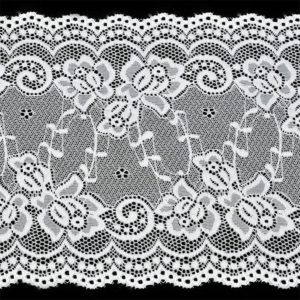 Fashion designers know a way to quickly transform an unremarkable item. Any detail, trim, or element using lace easily copes with the task. Thanks to intricate patterns, a typical item becomes original and sophisticated.
Fashion designers know a way to quickly transform an unremarkable item. Any detail, trim, or element using lace easily copes with the task. Thanks to intricate patterns, a typical item becomes original and sophisticated.
Lace is a classic way of decorating clothes, which remains relevant and in demand, despite changes in fashion trends.
The birthplace of this unusual fabric consisting of continuous patterns is Europe. Italian craftsmen were the first creators of man-made miracles, which they were able to create using an ordinary sewing needle and thread (linen, silk or cotton).
Woven patterns immediately became popular and spread throughout European countries. Belgium and France, England, Germany and other countries gradually developed their own traditions of making lace. Since the 17th century, lace openwork also appeared in Russia, which added originality and conquered the world with Vologda, Yelets and other laces made by the hands of Russian craftswomen.
Initially, all lace was made by hand.It was woven using bobbins, embroidered on fabric with needles, and created using special shuttles or simple forks. The process of making openwork fabrics was labor-intensive, so handmade lace always had a high price.
The 19th century opened a new page in lace history. This happened after a special machine for weaving lace was designed in France.
The mechanization of the process not only made it possible to create patterned fabrics faster. Now openwork fabrics have become more diverse and accessible.
Today, both methods of making lace are used. They are still made by hand, and they also use modern machines, the operation of which is based on new technologies.
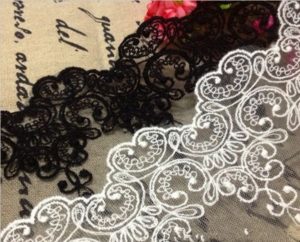 Lace is a special fabric, the basis of which is made up of various patterns with floral, geometric motifs or curls.
Lace is a special fabric, the basis of which is made up of various patterns with floral, geometric motifs or curls.
One of the main characteristics of lace is the method of its manufacture. Depending on this, all patterned fabrics are divided into 2 groups:
The group of handmade laces includes the following types.
Tatting - patterns woven from threads that have previously been twisted in a special way.
Richelieu – patterns on the canvas are first embroidered using stitches of different lengths and depths, and then carefully cut out.
Reference! Some types of hand lace can only be made on certain fabrics.For example, hardanger is made on a thick base (linen), Richelieu is made on very thin materials (cambric, muslin, organza).
The most popular machine-made lace fabrics are openwork and guipure.
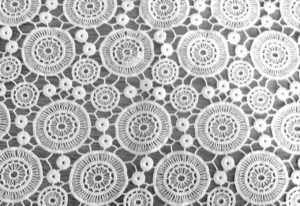 Modern lace fabrics are a product of modern sewing technologies.
Modern lace fabrics are a product of modern sewing technologies.
The machines on which woven patterns are created are equipped with programs that allow you to set the desired pattern to the equipment, select the technical complexity and color scheme (one-color or multi-colored fabric).
In addition, today it is possible to achieve the necessary elasticity of lace fabric. This property of the material is created by adding synthetic fibers to the main threads (silk, linen, cotton).
Patterned fabrics are a very unique material. When choosing such a fabric, it is necessary to take into account information about its advantages and disadvantages.
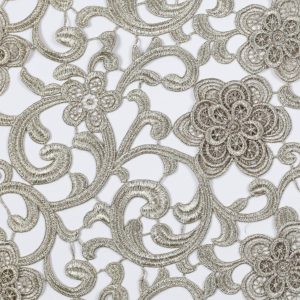 The main advantage of any lace is its beauty, thanks to which it is possible to decorate any item with lace elements.
The main advantage of any lace is its beauty, thanks to which it is possible to decorate any item with lace elements.Important! Hand and machine lace made from natural fibers has additional advantages: environmental friendliness And hypoallergenic.
The scope of lace is varied.
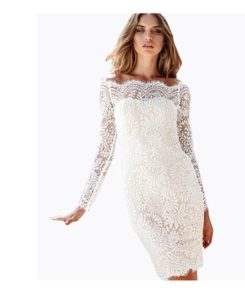 First of all, unusual material is used to create dresses for special occasions: weddings, celebrations, ballroom, evening, etc. In addition, there is a great demand for elegant lace items (blouses, scarves, stoles, etc.), which can be used to diversify a business suit for a special occasion.
First of all, unusual material is used to create dresses for special occasions: weddings, celebrations, ballroom, evening, etc. In addition, there is a great demand for elegant lace items (blouses, scarves, stoles, etc.), which can be used to diversify a business suit for a special occasion.
Lace is also used to make beautiful underwear, tights or stockings.
Accessories and jewelry made from patterned material are popular: small handbags, fans, brooches, earrings, necklaces, etc.
Home textiles are another area of using lace. Inserts or decorative trims with intricate patterns adorn bedding, curtains, tablecloths, and towels.
 Fabrics with lace patterns require careful and careful handling. To preserve their fragile structure, you need to follow the rules for caring for lace and take into account its composition.
Fabrics with lace patterns require careful and careful handling. To preserve their fragile structure, you need to follow the rules for caring for lace and take into account its composition.
Important! Proper care will be ensured by strict adherence to the recommendations for handling a specific material, which are contained on the label.
Advice! Laundry soap will help you easily wash lace fabric. The products are soaped and left in the soap solution for 20–30 minutes, and then rinsed several times.
Important! Only flat lace can be ironed. It is not recommended to use an iron to care for products with three-dimensional patterns!
Lace fabric is a classic that is always modern.